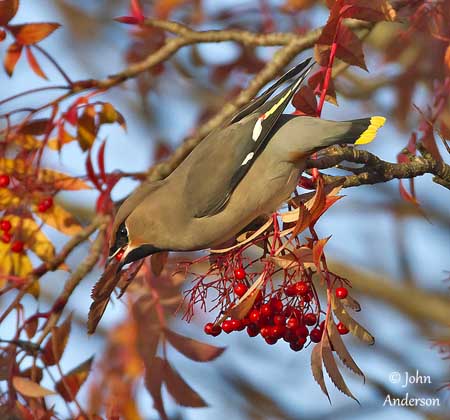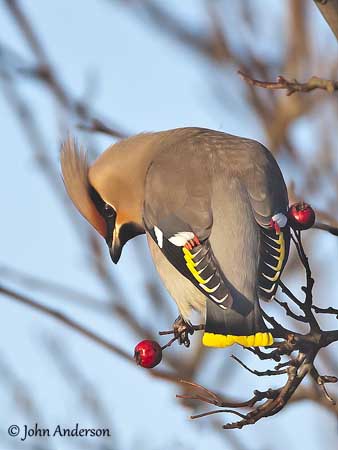
Fr: Jaseur boréal
All : Seidenschwanz
Esp : Ampelis Europeo
Ital : Beccofrusone comune
Nd: Pestvogel
Sd: Sidensvans
Photographers:
John Anderson
John Anderson Photo Galleries
Didier Buysse
Vision d’Oiseaux
Steve Garvie
RAINBIRDER Photo galleries
René Lortie
http://rlortie.ca/
Text by Nicole Bouglouan
Sources:
HANDBOOK OF THE BIRDS OF THE WORLD Vol 10 by Josep del Hoyo-Andrew Elliott-David Christie - Lynx Edicions - ISBN: 8487334725
THE HANDBOOK OF BIRD IDENTIFICATION FOR EUROPE AND THE WESTERN PALEARCTIC by Mark Beaman, Steve Madge - C.Helm - ISBN: 0713639601
L’ENCYCLOPEDIE MONDIALE DES OISEAUX - Dr Christopher M. Perrins - BORDAS - ISBN: 2040185607
ENCYCLOPEDIE DES OISEAUX DE FRANCE ET D’EUROPE – de Peter Hayman et Rob Hume - Flammarion – ISBN : 2082009920
BirdLife International (BirdLife International)
Animal Diversity Web (University of Michigan Museum of Zoology)
All About Birds (Cornell Lab of Ornithology)
Bird Web (Seattle Audubon Society)
What Bird-The ultimate Bird Guide (Mitchell Waite)
Bohemian Waxwing
Bombycilla garrulus
Passeriforme Order – Bombycillidae Family
BIOMETRICS:
Length: 19-23 cm
Wingspan: 33 cm
Weight: 55 g
DESCRIPTION:
The name of the Bohemian Waxwing comes from its striking wing pattern. The flattened tips of the secondary flight feathers are bright red and appear like wax drops.
The adult male of nominate race has brownish-grey plumage with paler and greyer rump and underparts, and dark chestnut-orange undertail-coverts.
On the wings, flight feathers are blackish. The primary tips show yellow edges on outer webs, and narrower white edges on inner webs. This pattern forms a yellow stripe and several white fishhook-like markings on closed wings. Primary coverts and secondaries show broad white tips. Secondaries also have long, flattened wax-like red tips.
The tail is blackish, with a conspicuous bright yellow terminal band.

On the head, crown and malar area are cinnamon to warm tawny. There is a black mask from bill base, through the eye and to rear of the head under the prominent backward-pointing crest. We can see a narrow white arc below the eye, and a white streak below the gape. Chin and throat are black.
The bill is black with pale base. The eyes are dark brown. Legs and feet are dark grey to black.
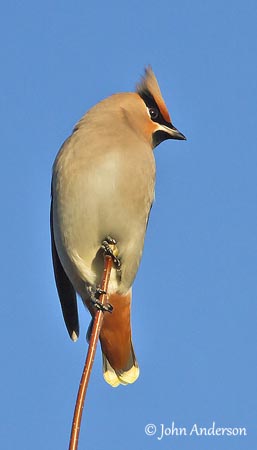
The female is very similar, but she has narrower yellow terminal band. The black throat is less well defined on the lower edge. She has fewer or shorter red tips on secondaries.
The juvenile is duller than adults and greyer, with shorter crest, less extensive black mask and no black patch on throat. The wing pattern is less conspicuous and the tail band is narrower. Underparts are whitish and slightly streaked brownish.
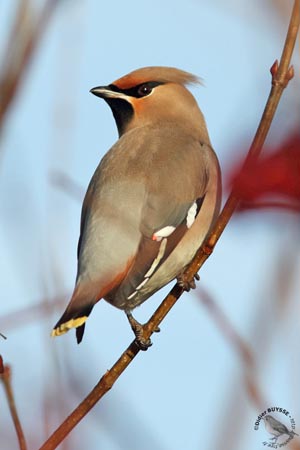
We can find three subspecies:
B.g. garrulus (here described) breeds in northern parts of Sweden, Norway, Finland and Russia. Non-breeding birds occur S to Poland, the Balkans, Ukraine, and it is irregular farther south.
B.g. centralasiae breeds in C and E Russia, from Ural Mts, E to Sea of Okhotsk and Kamchatka, S to Altai Mts, Baikal Lake and lower Amur valley. Non-breeding birds are found S to Kazakhstan, N China and Japan.
This race is generally greyer than nominate, and has paler head with less cinnamon in malar area.
B.g. pallidiceps breeds in NW and NC North America. Non-breeding grounds are found E to SE Canada (Newfoundland) and S to C and NE United States.
This one is slightly paler with less bright colours than nominate. It has more cinnamon on head than previous.
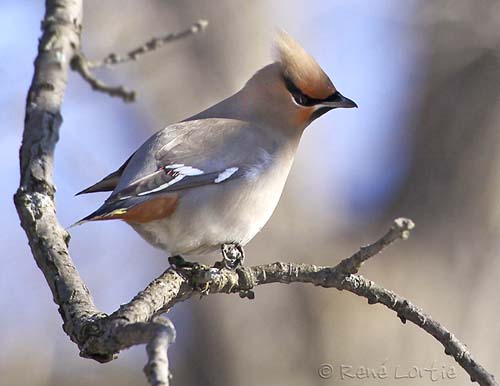
VOICE: SOUNDS BY XENO-CANTO
The Bohemian Waxwing utters a weak, trilled, shivering “sirrr” when perched or in flight.
The song is a soft, sustained series of quiet, trilled phrases, similar to the previous call but mixed with other sounds such as wheezy notes and harsh scraping sounds.
HABITAT:
The Bohemian Waxwing breeds in northern coniferous forests, mainly in open forest or edge and near rivers, with areas where it can find dense growth or fruiting trees and bushes.
During winter, it frequents various types of habitats with scattered trees and fruiting trees and bushes. It can be seen in gardens, farmland, roadsides and deciduous forest edges.
RANGE:
See above in “subspecies”
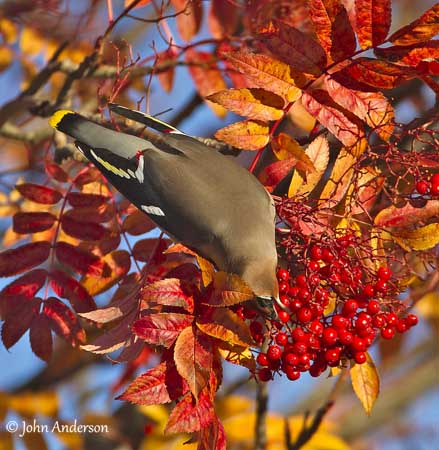
BEHAVIOUR:
The Bohemian Waxwing is mainly a fruit-eater, but it also feeds on insects, especially during the breeding season. It also takes buds, flowers, tree sap, shoots and leaves, moss and lichens. The diet is complemented by spiders and snails.
It depends on fruit availability in non-breeding season, but it also feeds on fruits during summer. It forages in fruiting trees and bushes, and sometimes a flock can remove all the fruits in only a few hours or days. Insects are usually caught by gleaning and aerial flycatching.
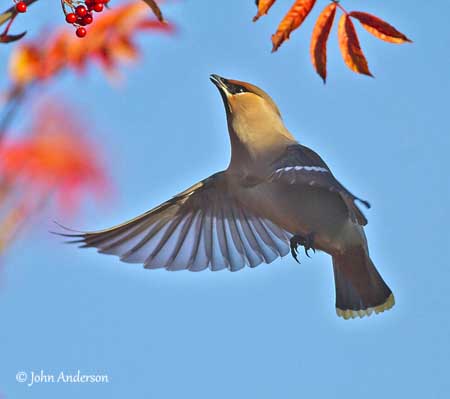
The Bohemian Waxwings are gregarious almost all year round, and are often found in flocks outside the breeding season, including 200, 1000 and up to 3000 birds have been observed.
They are mainly arboreal and cling to twigs and branches with great agility, whereas they perform only short hops on the ground.
They gather at communal roosts, usually in trees with thick foliage, or hedges, but also in sheltered places of buildings or beneath dense cover on the ground.
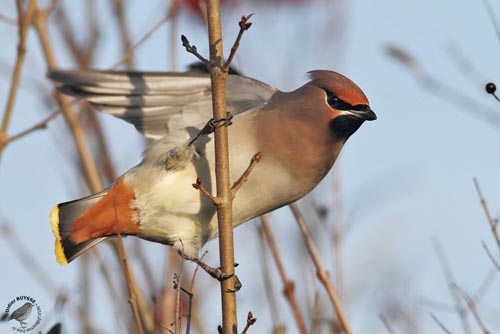
The Bohemian Waxwing often performs some courtship displays in winter flocks, as early as late November, but this behaviour lasts until late June. The male erects the crest and the grey rump feathers.
We can see exchanges of food between male and female, with one bird hopping away while holding the food in the bill before to join the second bird. This behaviour called “courtship-hopping” is often initiated by the male and sometimes, both birds only touch their bills without any exchange of food. After several exchanges, up to 12 and more, the display ends when one bird, often the female, eats the food item. Copulation usually follows these displays.
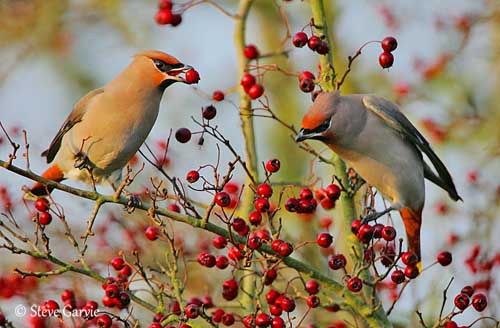
The male keeps other males away from the female as egg-laying approaches. The male adopts an upright posture in front of rivals, or leans forwards with open bill. This species also needs to defend the nest, because waxwings often steal nest materials in other nests, including those of their own species.
However, they tolerate conspecifics near the nest, and several pairs often nest in close proximity to one another. They have been observed nesting in an almost colonial behaviour at times, with 6-12 pairs within a small area. But most pairs nest usually solitary.
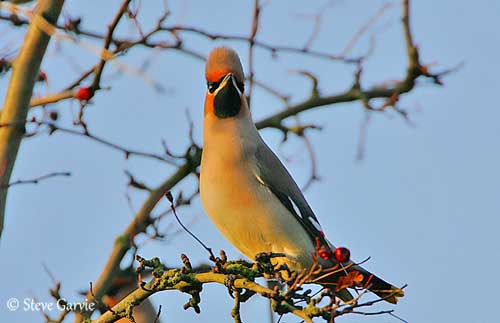
The Bohemian Waxwing is partial migrant, with large numbers leaving the breeding grounds in winter. They do not show fidelity to wintering sites, and they wander largely during winter months according to food availability.
FLIGHT:
The Bohemian Waxwing has long-pointed wings allowing fast flight. They have direct flight on short distances, with steady wingbeats. Over long distances, wingbeats are interspersed with glides, but the flight is not deeply undulating.
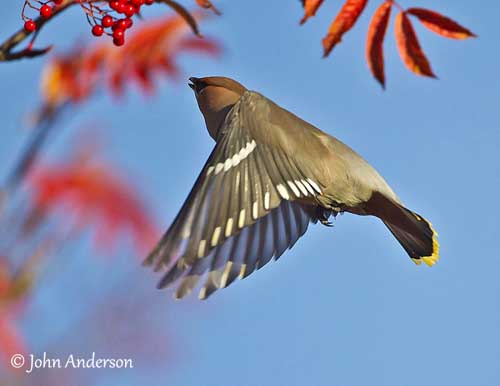
REPRODUCTION:
The breeding season is relatively late, with laying from mid-June to end of July.
The Bohemian Waxwing appears monogamous. Both sexes build the nest, an open cup made with twigs and coarse grasses. The inner cup is lined with softer materials such as fine grasses, mosses, plant fibres, feathers and mammal fur. The nest is placed close to the trunk on horizontal branch, between 1,5 and 15 metres above the ground, in forest or wet areas.
The female lays 3-7 eggs and incubates during about two weeks. She is fed on the nest by the male during this period. Both parents feed the chicks which fledge about 15-17 days after hatching.
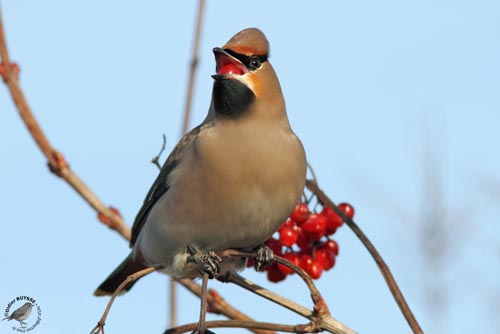
DIET:
The Bohemian Waxwing feeds on fruits and insects, but it also takes buds in several tree species, flowers, sap, bark, shoots, leaves, moss and lichens, with in addition, spiders and snails.
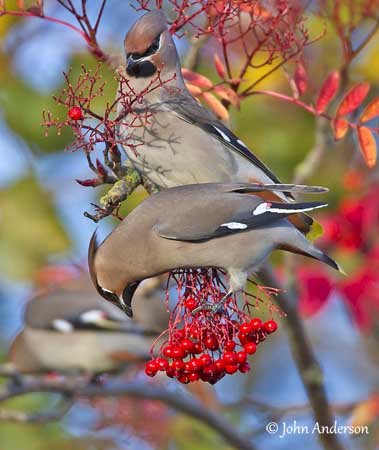
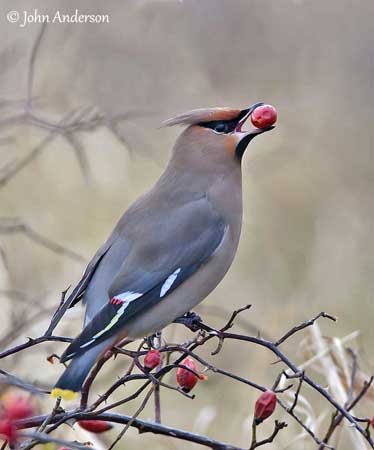
PROTECTION / THREATS / STATUS:
The Bohemian Waxwing is common with stable populations and even some increase in recent years.
This species is not currently threatened.
